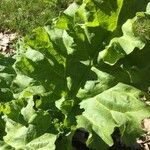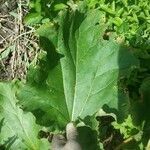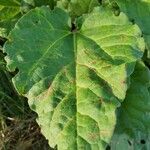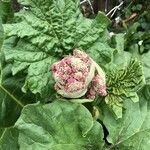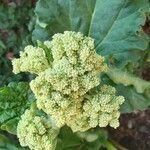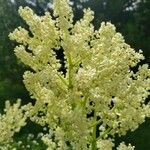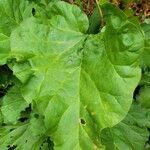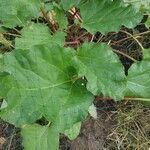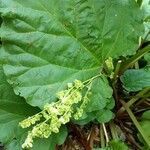Plants 3-20(-30) dm. Stems striate, often striped or suffused with red or pink, branched distally, hollow. Leaves: ocrea brown, loosely funnelform, 2-4 cm, margins strongly oblique, glabrous or puberulent with flattened, whitish hairs along veins; petioles of basal leaves pinkish green or reddish green, ca. equaling or longer than blade, thick, fleshy, those of cauline leaves absent distally; basal leaf blades palmately veined with 5-7 basal veins, 30-45(-60) × 10-30 cm, veins pubescent primarily along veins with flattened, whitish hairs. Inflorescences 250-500-flowered, 15-40 cm; peduncle 1-8 cm, glabrous. Pedicels articulated at or proximal to middle, 2-5 mm, glabrous. Flowers: tepals oblong-ovate, 2.3-4 × 1-2.5 mm, margins hyaline, apex obtuse. Achenes 6-10(-12) × 6-11 mm including wings, 4-8 times longer than perianth; wings tan, veined, 3-4 mm wide, membranous. 2n = 44.
Glabrous herb. Lvs mostly radical, arising from thick woody rhizomes. Petiole to c. 60 × 3 cm, flattened above and with raised margins, ± crimson, especially towards base; ochreae to c. 8 cm long, brown, scarious. Lamina to c. 50 × 40 cm (larger in cultivation); main veins 7, prominently raised below; margins ± undulate. Infl. to c. 1.5 m tall; main stem massive and hollow; lateral branches numerous. Bracts minute. Fls greenish white; pedicels filiform, jointed, commonly c. 5 mm long. Inner 3 perianth segments 2.5-3 mm long, elliptic to suborbicular; outer 3 segments smaller. Stigmas large, irregular in outline. Fr. to c. 1 cm long; wings broad, reddish.
See Rheum x hybridum. Our common edible rhubarb is developed from this plant by hybridisation. A stemless herb. It is a herb that keeps growing from year to year. It grows 60-80 cm high. The rootstocks are stout and 8-12 cm across. The leaves near the base are in a ring. The leaf stalks are 15-30 cm long and fleshy. The leaves near the base are oval or triangle shaped. They are 10-16 cm long by 8-14 cm wide. They can be larger. They have shallow lobes. The edges are wavy. The flowering stems are 1-1.5 m high.
A coarse perennial with large basal lvs, stout petioles, 6 tep, 6 stamens, and 3-winged achenes, occasionally escapes from cult. (R. rhaponticum, misapplied)
